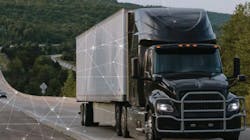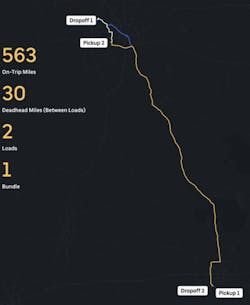Uber Freight shifting to sustainable shipping
As California plans to eliminate the sale of fossil-fuel trucks in the state by 2036, Uber Freight is using its logistics capabilities to aid shippers and carriers nationwide in efforts to decarbonize.
There are two main ways that the Uber Freight platform can help trucking stakeholders decarbonize, according to Chinmay Jaju, Uber Freight's senior manager of business development. The first is by supporting shippers with emissions transparency and accountability.
"It's hard to improve what you can't measure," Jaju told FleetOwner. "So for the past several years, we're getting to a point now where we're having very good visibility into emissions, with good reporting and insights and engagement across both sides of our marketplace."
The second way the company decarbonizes is by optimizing its freight network, both by working with shippers individually to optimize routing and by algorithmically ensuring that carriers are not hauling empty miles.
Then there's optimization that happens across the Uber Freight network nationwide. For example, the company's algorithm suggests bundled loads, where two loads are combined algorithmically to maximize paid time on a trip. According to Uber's research, its bundling algorithm can reduce deadhead by almost 23%.
Surveying shippers' EV preferences
Uber surveyed its shippers about their demand for—and willingness to pay for—electric vehicles.
According to respondents, some shippers have a monetary amount they're willing to pay to have an EV haul their load. Others may have a significant preference where, although they would not pay extra to utilize an EV, the shipper prefers electric vehicles, and all things being equal, an EV would win the bid.
Preference may also take the form of preferential treatment at facilities, Jaju said.
"EVs have to spend some time of their day charging, so if shippers are willing and able to give priority loading, be flexible with appointment times, or convert certain loads to drop loads in order to accommodate EVs' constraints and schedules," it can greatly increase the practicality of EV deployment, he said.
As the Uber Freight platform continues to develop, Jaju said that in the future, shippers may be able to indicate EV preference when tendering loads, such as by paying a premium to use an electric truck or by indicating that they're willing to hold onto a shipment longer if it means it will eventually be picked up by an EV.
See also: Fleets try to meet shippers' newest request: sustainability
The company's commitment to facilitating electric vehicles is perhaps best exemplified by its partnership with WattEV. Uber Freight can analyze, based on vehicle range, charging availability, and WattEV's schedule, which shippers best fit.
"Based on our deep relationships with these shippers," Jaju said, "we're able to shuffle things around and say, 'Hey, you guys bid out this lane, and someone has been awarded that … Can we swap that out with something else for that carrier to keep them happy? Because we really need that lane, that consistency to make an EV work over here.' It's this massive game of Tetris."
Partnering for clean trucks
As the industry continues to experience the growing pains of sustainable technology development, Jaju underscored the importance of trucking's various stakeholders working together, making concessions where necessary, such as those made between the California Air Resources Board and engine manufacturers in the Clean Truck Partnership announced last month.
"A lot of this stuff is incredibly, incredibly hard," Jaju said of decarbonization. "I think a lot of folks in the industry do view some of these regulations as impossible, and we're going to find out if they're ambitious, or impossible, or a little bit of both.
"But given that situation where there are bottlenecks, and there's all this stuff that's outside your control, collaboration is key to making sure we solve these problems together."
About the Author
Scott Keith
Scott Keith is a former fleet owner digital editor, who was on staff from 2022 to 2023.


